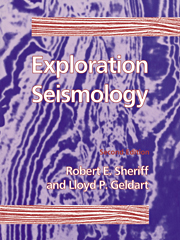Book contents
- Frontmatter
- Contents
- Preface
- Mathematical conventions and symbols
- 1 Introduction
- 2 Theory of seismic waves
- 3 Partitioning at an interface
- 4 Geometry of seismic waves
- 5 Seismic velocity
- 6 Characteristics of seismic events
- 7 Equipment
- 8 Reflection field methods
- 9 Data Processing
- 10 Geologic interpretation of reflection data
- 11 Refraction methods
- 12 3-D Methods
- 13 Specialized techniques
- 14 Specialized applications
- 15 Background mathematics
- Appendices
- Index
2 - Theory of seismic waves
Published online by Cambridge University Press: 05 June 2012
- Frontmatter
- Contents
- Preface
- Mathematical conventions and symbols
- 1 Introduction
- 2 Theory of seismic waves
- 3 Partitioning at an interface
- 4 Geometry of seismic waves
- 5 Seismic velocity
- 6 Characteristics of seismic events
- 7 Equipment
- 8 Reflection field methods
- 9 Data Processing
- 10 Geologic interpretation of reflection data
- 11 Refraction methods
- 12 3-D Methods
- 13 Specialized techniques
- 14 Specialized applications
- 15 Background mathematics
- Appendices
- Index
Summary
Overview
The seismic method utilizes the propagation of waves through the earth. To introduce the basic concepts of wave motion, we first discuss waves on a stretched string (§2.1.1) and introduce definitions of phase, frequency, wavelength, and other terms dealing with periodicity. Because wave propagation depends upon the elastic properties of the rocks, we next discuss some of the basic concepts of elasticity. (For more thorough treatments, see Saada, 1974, or Landau and Lifshitz, 1986.)
The size and shape of a solid body can be changed by applying forces to the external surface of the body. These external forces are opposed by internal forces, which resist the changes in size and shape. As a result, the body tends to return to its original condition when the external forces are removed. Similarly, a fluid resists changes in size (volume) but not changes in shape. This property of resisting changes in size or shape and of returning to the undeformed condition when the external forces are removed is called elasticity. A perfectly elastic body is one that recovers completely after being deformed. Many substances including rocks can be considered perfectly elastic without appreciable error provided the deformations are small, as they are in seismic surveys.
The theory of elasticity relates the forces that are applied to the external surface of a body to the resulting changes in size and shape. The relations between the applied forces and the deformations are most conveniently expressed in terms of the concepts of stress and strain.
- Type
- Chapter
- Information
- Exploration Seismology , pp. 33 - 72Publisher: Cambridge University PressPrint publication year: 1995
- 1
- Cited by



